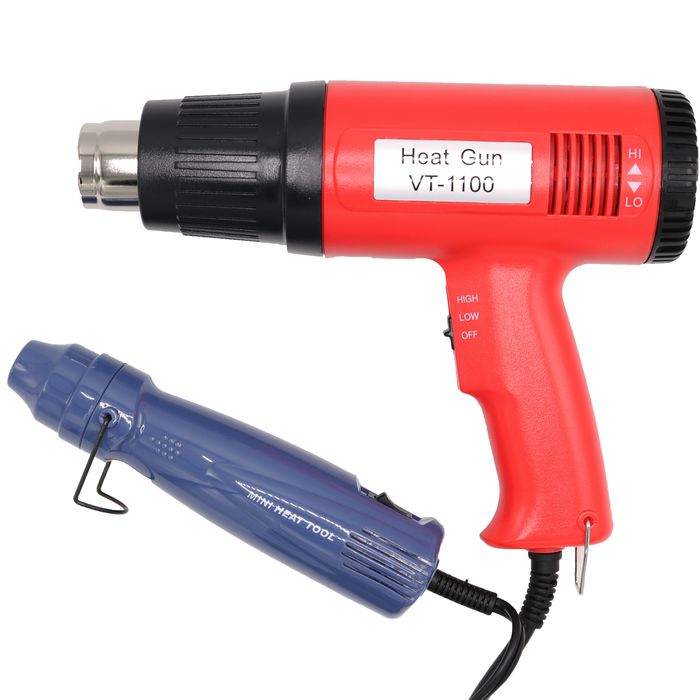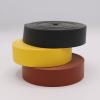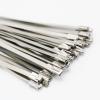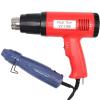
Heat guns are an excellent tool for any handyperson’s repertoire. These flameless, power tools use a motor, heating element and fan to direct hot air through a nozzle for a variety of applications. Heat guns are superior to other heat-producing tools thanks to features like adjustable temperature, secure stand, incredible power, and adjustable airflow.
Heat guns can be used for a variety of projects like stripping paint, car wrapping, heat shrinking tubes, removing adhesives, drying timber, thawing frozen pipes, and so much more.
As mentioned, heat guns are a flameless tool. This is also why they have a leg up over other heat-producing tools. Open flames can damage the surface you’re trying to heat, or start a fire. The hot air produced by a heat gun produces the same effect but is much safer for expert craftspeople or DIY-ers alike, and for the materials you’re working with (like heat shrink tubing).
There’s a lot to look for when buying the best heat gun for your heat shrink tubing like size, voltage, or temperature capabilities. So, whether you’re a professional, hobbyist or just in need of a heat gun, this guide should help you pick the perfect heat gun for your heat shrink tubing needs.
Why do you need a heat gun?
Before we get into the finer details of different heat guns, it's important to know what you will be using the heat gun for. Like most power tools, heat guns are designed based on usage requirements. A heat gun designed for working conditions will be more resistant to wear and tear, whereas one designed for hobbyists might include different features. It’s also important to note that heat guns created for light use are typically not covered under warranty if used strenuously.
So are you a professional that will need something to withstand consistent working conditions or are you a DIY-er that only requires light use of their heat gun? Perhaps for the electronics fanatic heat shrinking cable sleeves in their spare time?
Features to look for in a heat gun
Once you figure out how often you will be using your heat gun, some other important things to look out for are wattage, voltage capability, heat and airflow controls. Read on to find out more about each of these features.
Power capabilities
Most heat guns are corded electric models and according to Tooled-Up, DIY models usually start at around 1800 watts while professional tools can be rated at 3400 watts. There are also multiple 240v options for plugging straight into your main electrical system. For the professional, some heat guns are equipped with 110v, so they can be used safely in industrial environments like construction sites. Cordless heat guns are available, being powered by a lithium ion battery.
Adjustable temperature
Heat guns have a variety of applications, therefore they are designed with temperature controls to ensure you have the right heat for the right project. On basic models, you can usually find two or three fixed settings, and on more advanced versions you will have several controls that focus not only the temperature but where the heat comes out. On average, “DIY models have a fixed 930°F setting with one lower setting for tasks that require less heat.”
For example, the VT-1100 Heat Gun has a temperature range from 250 to 1100°F and can be controlled by the dial on the back of the unit, making it the perfect tool for a variety of uses.
Temperature cut-off
Like with any power tool, heat guns can overheat. Temperature cut-off is featured in a lot of modern heat guns like the Mini Electric Heat Gun, which features overheat protection. This helps to ensure that the internal temperature of the heat gun does not go above a predetermined threshold. By helping to prevent damage from extreme temperatures, temperature cut-off also extends the life of heat guns.
Adjustable Airflow
Airflow is another aspect you have the power to control on your heat gun. This function allows you to lower the force of the blast being directed at your material. This is a great function, especially if you’re working with lighter materials or sensitive surfaces. On the other hand, higher airflows can lead to quicker results.
Just like with the temperature control settings, the airflow control functions are based on fixed speed settings or dials that allow for even more focused capabilities.
Heat indicators
The nozzle of a heat gun has got to be able to take the heat. As such, it can also stay hot for a long time after use. This poses a danger to the user, who will often go back and get burned by grabbing the nozzle. A residual heat indicator displays a warning light for the user that will turn off once the heat gun has cooled down.
For the hobbyist to professional
If you’re interested in more advanced functions for your heat gun, below are some bonus features to look for:
Displays
New models of heat guns now feature LCD or LED displays. This is a huge benefit to the professional as it can help them with precision to ensure consistent results and the ability to work confidently.
Temperature scanners
Either already fitted or can be purchased later on, a temperature scanner will read the temperature at the point where the hot air is making contact. This helps the user to better control the heat being applied, by focusing on the area rather than the machine itself. Have you ever burned yourself on a bowl of food from the microwave? The same concept applies here.
This handy feature also helps to identify the surface conditions in temperature critical applications.
Freestanding capabilities
If you need a different angle to get those hard to reach places, some heat guns are also designed to be freestanding, or with a moveable stand that allows it to be stationary while you work the heat shrink tubing through the hot air. The Eddy Mark IV Gun includes a circular safety stand that helps to keep the heat gun balanced while you work.
Other accessories
A final addition to be sure to look out for are add-ins like extra nozzles. Extra nozzles are useful for both replacement needs but also to create different sized surface area options for direct heat placement.
Want to know more about heat guns?
Hopefully, this guide has helped you understand all you need to know to choose the best type of heat gun for your application. Set up an account or log in to put in an order.
If you have additional questions, visit our learning center or FAQs. Or you can contact us here with questions or to receive a sample.








